Economics
Capitalize on junior’s delta – Richard Mills
2023.04.12
Investors frequently turn to gold and silver during periods of geopolitical uncertainly and economic turbulence.
Heightened global tensions…

2023.04.12
Investors frequently turn to gold and silver during periods of geopolitical uncertainly and economic turbulence.
Heightened global tensions such as terrorist attacks, border skirmishes or civil wars scare investors into putting their funds into safe havens like gold and stable, high-yield sovereign debt.
Driven by fears induced by the banking sector and the imminent end to Federal Reserve’s tightening cycle, investors are turning their attention to precious metals to hedge their bets. For most, the unwritten rule is that during times of financial uncertainty, gold (and by association silver) is the way to go.
Last week, the gold price shot up by nearly 2% to its highest in a year at around $2,020 an ounce, just $50 shy of an all-time high. Silver also rode on the back of this rally, up 3.7% for the week.
On Tuesday, April 11, gold hit an intra-day high of $2,006.30, at time of writing trading at $2,003.70 in New York.
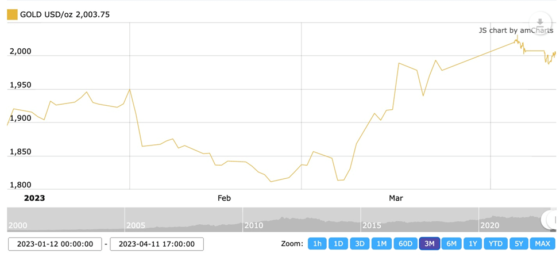
The bullish sentiment is being echoed across the analyst community. In March, those at Goldman Sachs reiterated their positive outlook on commodities and upped their 12-month gold forecast by a hefty $100 to $2,050/ounce. Fitch Solutions was even more aggressive, predicting that gold would notch $2,075, matching its all-time high, “in the coming weeks.”
Silver may even outpace its sister metal and hit a nine-year high of $30 per ounce this year, Refinitiv analysts told CNBC.
Economic safe haven
As we wrote earlier, one of the biggest forces behind gold’s rising demand is central banks, which hold gold bullion as part of their monetary reserves. This is because gold, like currency, is a safe, liquid asset, and offers the benefit of diversification.
For the last decade, CBs have stacked up on gold to meet their financial obligations. Bloomberg reported that central banks have been buying the most gold since the United States abandoned the gold standard in 1971, with total purchases setting a new 50-year record in 2022.
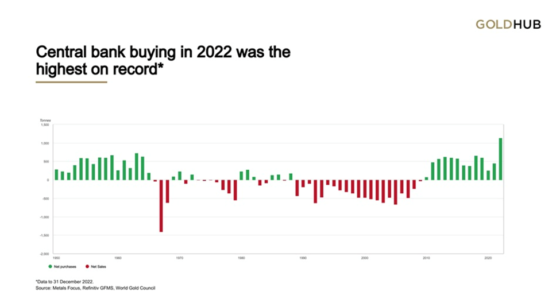
There’s no sign of slowing down in 2023 either. Recent World Gold Council data shows central banks added another 125 tonnes during the first two months, the strongest start to a year since becoming net buyers in 2010. The countries with the largest purchases were Singapore, Turkey, China, Russia and India.
Who are behind the gold and silver buying
Retail investors, meanwhile, have been snapping up physical metal out of concern that inflation may be more persistent than professional money managers believe, according to WGC.
The second half of 2022 was particularly strong, achieving two successive quarters of demand in the neighborhood of 340 tonnes for the first time since 2013.
With respect to gold-backed ETFs, after 10 straight months of capital outflows in favor of stronger alternatives, the dollar and Treasuries, investors are beginning to shift back to these products following the recent banking crisis. New WGC data shows global gold-backed ETFs saw inflows of $1.9 billion (32 tonnes) last month on heightened safe haven demand.
“With a US recession still on the cards, growing systemic risk adds to gold’s case,” the World Gold Council said, adding that the March inflows were the highest since 2019.
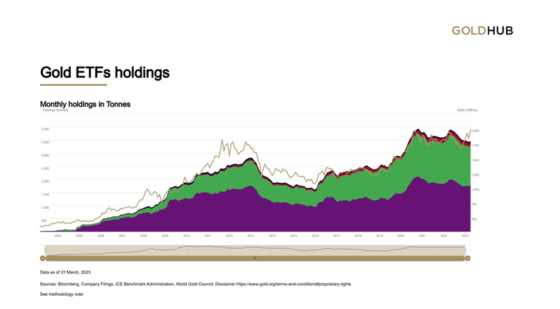
On top of massive gold-buying by central banks, we also have the gradual diminishment of the US dollar and many countries’ need for it. “De-dollarization” is being pursued by countries with agendas at odds with the US, including Russia, China, Saudi Arabia and Iran.
Russia and China have both made moves to de-dollarize and set up new platforms for banking transactions outside of SWIFT that skirt US sanctions. The two nations share the same strategy of diversifying their foreign exchange reserves, encouraging more transactions in their own currencies, and reforming the global currency system through the IMF.
Without taking action to reverse this trend, Washington will see its global standing weaken.
According to The Cradle columnist Pepe Escobar, The nine permanent SCO [Shanghai Cooperation Council] members now represent 40 percent of the world’s population. One of their key decisions in Samarkand [Uzbekistan, site of the 2022 SCO Summit] was to increase bilateral trade, and overall trade, in their own currencies.
The importance of this cannot be underestimated: 40% of the world’s population is no longer interested in conducting trade using US dollars!
For the past several years, China has taken steps to internationalize the yuan and make it investable through the purchase and sale of gold bullion.
Rise of the gold-backed e-yuan
New data from the International Monetary Fund shows the share of the US dollar as a percentage of global exchange reserves fell to 58.4% at the end of the fourth quarter, which is the lowest share since 1994.
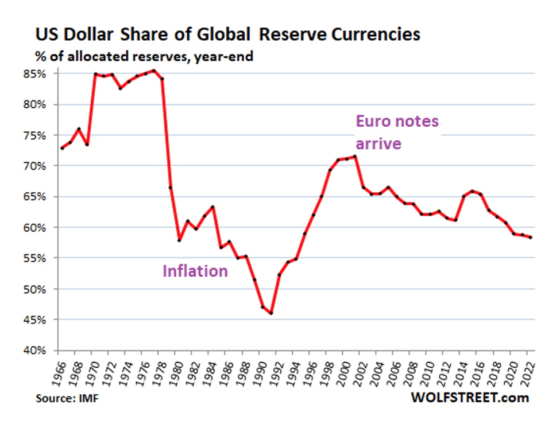
As a comparison, the dollar’s share of global exchange reserves was 85% in 1978. According to Wolf Street, while holdings of dollar assets rose from $4.4 trillion in 2014 to $7.1 trillion in Q3 2021, there was a $621 billion drop in USD holdings in the fourth quarter of that year, when the Fed started talking about ending QE and kicking off rate hikes.
Dollar assets, of course, include US Treasuries, which is essentially US debt carried by domestic and foreign entities, without which the US government would be unable to run its huge annual deficits.
Economist Nouriel Roubini says long-term Treasuries aren’t the safe haven investors should pursue as a hedge against risk. “Last year you lost 20% on your safe bonds — the solution is going to be short-term Treasuries, TIPS, gold and other precious metals,” he says on ‘Bloomberg Surveillance’.
Part of the reason people like investing in gold and silver is their disdain for government-issued digital currencies. A Central Bank Digital Currency (CBDC) is a digital form of money issued by a central authority.
Critics point to the inherent danger of a system that could usher in the “globalist” vision of a cashless society in which all transactions are traceable by government. Moreover, a CBDC is similar to traditional fiat currency issued by a central bank, and would therefore suffer from the same inflationary issues if the CB decided to issue more of it — like printing cash.
The coming cashless society and gold
M2 money supply is a measure of how much cash and cash-like assets (e.g. bank deposits, money market funds) is circulating in the US economy. M2 contracted in December for the first time since the 1940s, falling a non-seasonally adjusted 2.2% to $21.099 trillion in February, from the same period a year earlier.
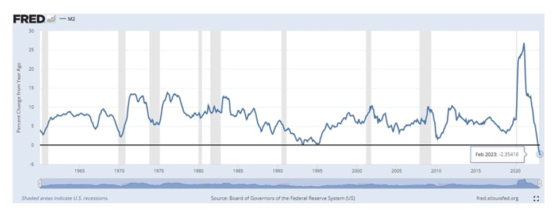
The contraction is due to the US Federal Reserve purposefully unwinding its balance sheet by selling government bonds and other assets, a process known as quantitative tightening, or QT.
The reduction of US money supply is a red flag for the economy and financial markets. A Reuters article states that, all things being equal, it is a sign the Fed has no need to raise interest rates further. Given the lag of one to two years between money supply changes and the impact on asset prices and inflation, it may even be a sign that the U.S. central bank should be cutting rates.
For the first time ever, last September, it was reported the Fed lost money, almost 3/4 of a trillion dollars on a mark to market basis — result of the plummeting prices of the Fed’s government bonds and mortgage-backed securities.
The Fed’s loss at the end of the second quarter was 17 times its total capital, making it deeply insolvent on a mark to market basis. If the Fed was a regional bank it would have been closed and taken over.
The increase in long-term interest rates is leading to massive losses for creditors/banks holding long-duration assets such as 10, 20, 30-year Treasuries. The economy is thus falling into a “debt trap”, and central banks confronting this dilemma will end their monetary tightening/ inflation fight so as to avoid a financial and economic meltdown.
To be clear, the Fed must pivot; there is no alternative. It’s unlikely the Fed will raise another 0.25% in May. If they do it’ll be the last raise and they will pause over the summer. The dollar will weaken and precious, industrial and battery metals will soar in price.
Geopolitical safe haven
Consider that gold jumped to within $50 of its all-time high with the failure of three banks. What’s going to happen to gold if we get a recession? Or if one of four hot spots in 2023 — the war in Ukraine, Iran protests, US-China trade relations, and North Korea — flares up?
A run through some of these conflicts, and the latest from the always-unstable Middle East, will show the necessity of owning precious metals in a world that has become increasingly unsafe.
Ukraine
Russian forces pounded cities in eastern Ukraine, Tuesday, with the offensive in the Donetsk region seeing several towns and cities come under heavy bombardment.
One year and 45 days after Russia’s invasion of Ukraine on Feb. 24, 2022, there appears to be no sign of the conflict coming to an end.
“The enemy switched to so-called scorched earth tactics from Syria. It is destroying buildings and positions with air strikes and artillery fire,” Colonel General Oleksandr Syrskyi, commander of Ukraine’s ground forces, said via Reuters.
Meanwhile the largest US military leak in a decade has created an intelligence threat for Ukraine’s military forces ahead of an expected counteroffensive this spring. According to The Hill,
Classified documents leaked on social media offer extensive details about munitions, training and air defense systems at a critical point in the fight.
While they only provide a status of the conflict up to March, the material does reveal insight into Ukraine’s military capabilities, including battalion sizes, training on advanced weaponry and deployment of heavy combat vehicles, such as Leopard II tanks.
They also give a view into Kyiv’s shortcomings, with at least one document describing how the country could soon run out of munitions for Soviet-era anti-air missile systems, exposing a potential vulnerability in Ukraine’s air defense systems.
One document, dated in February, says missiles for the S300 will run out by May, while the SA-11 Gadfly missile system will be depleted by the end of March. Both systems make up 89 percent of Ukraine’s air defenses, according to NATO, and are crucial in fending off frequent Russian missile strikes.
North Korea
An armistice to end the Korean War was signed on July 27, 1953, and the country partitioned along the 38th parallel, but a state of war has persisted ever since.
While North and South Korea often talk of re-unification, the reality is there is a huge gap between the north — poor, rural and ruled for the past 80 years by a brutal dictatorship — and rich, democratic, heavily industrialized South Korea, which is backed by the United States.
In 2017 Donald Trump struck up a dialogue between himself and Kim Jong-un, even meeting the North Korean President in person to negotiate an end to its long-range missile and nuclear weapons programs.
But the talks came to nought and before long the North was back to flinging test missiles.
Near the end of March, North Korea launched two short-range ballistic missiles off the east coast of the Korean Peninsula, the latest in series of missile firings as South Korean and United States forces engage in their largest military exercises since 2017, CNN reported.
The reclusive and heavily armed DPRK last year conducted a record number of missile tests while pledging to develop its nuclear program to arm the missiles.
The military exercises on the southern part of the Korean Peninsula involve thousands of troops, along with two large US navy platforms, the USS Nimitz and the amphibious assault ship USS Makin Island.
Taiwan
China sees self-ruled Taiwan as a breakaway republic that must be re-united with the Motherland. President Xi Jinping has said reunification with Taiwan “must be fulfilled” and has not ruled out the use of force to achieve this goal.
Taiwan’s opposing view is to see itself as distinct from the Chinese Mainland, with its own constitution and democratic elections.
Caught in-between is the United States, which officially “acknowledges the Chinese position that there is but one China and Taiwan is part of China”, but continues to sell arms to the Taiwanese military.
The Chinese Communist Party has not ruled out military action to achieve reunification, and the United States hasn’t said it won’t defend Taiwan in the event of an attack. This unstable situation, along with a number of recent events, makes the risk of war greater than previously.
Why China won’t go to war with Taiwan
Lately, Taiwanese President Tsai Ing-wen has been trying to shore up Taiwan’s diplomatic alliances including a trip to California to meet US House Speaker Kevin McCarthy. Associated Press reported China responded to the meeting by imposing a travel ban and financial sanctions against those associated with Tsai’s US trip and with increased military activity through the weekend.
China
Staying with China for the moment, French President Emmanual Macron has apparently been trying to recruit President Xi Jinping into playing a major role in building peace between Ukraine and Russia.
Contrasting with American skepticism of Beijing — the United States for months has warned that China is considering sending weapons to Russia for use in its war in Ukraine — Macron’s visit to China highlights
France’s focus on maintaining, if not strengthening, economic ties to China, The Hill reported on April 8:
While the Biden administration and lawmakers on both sides of the aisle describe Xi as working to reshape the world in the view of China’s authoritarian model, European leaders are less unified on the risks versus rewards of close ties with Beijing…
French officials say they do not see a conflict of interest between maintaining trade ties with China while trying to engage Xi to act more responsibly.
“Talking with China and having direct engaging discussions doesn’t mean you erase the economic ties,” one French diplomat told The Hill.
Such ties between the United States and China are becoming increasingly strained. Remember, the Biden administration has yet to lift the hundreds of billions of dollars worth of tariffs slapped on Chinese imports during Trump’s trade war.
On April 10 the Manila Times reported a new front in the trade war is opening up over rare earths. If true, the development would be a repeat of what happened in 2010, when China suddenly imposed export restrictions on rare earth oxides following a dispute with Japan, causing the prices of most REOs to soar.
According to the newspaper, China is considering suspending the export of “certain rare-earth magnet technology” in retaliation for the United States earlier restricting the export of advanced semiconductors, also known as computer chips.
The Middle East
China, meanwhile, is gradually becoming a power broker in the Middle East, a role that historically the United States has played.
On March 10, Iran and Saudi Arabia signed an agreement brokered by China to end a seven-year rupture of diplomatic relations, The Economist reported.
The two adversaries have been fighting a proxy war in Yemen and have been on opposite sides of conflicts in Lebanon, Syria, and Iraq.
Note the Saudis and Iran have begun accepting Chinese yuan instead of dollars for their oil.
Competition for US dollar intensifying
“If you create a diplomatic vacuum, someone’s going to fill it. That’s basically what’s happened to US policy in the Gulf,” Vox quotes a retired career diplomat with extensive experience in the Middle East and China. “It’s a really major development.”
Chas Freeman explained that China is “trying to produce a peaceful, international environment there, in which you can do business.”
That only makes sense, given that China is the largest trading partner of the Gulf and most of the Middle East. Reminds me of an old saying: “Money talks, bullshit walks.”
As China cozies up to Saudi Arabia and Iran, arguably the two most important players in the region, Israel, a US ally, has come under renewed attack from its old enemies.
According to The Economist, for five days starting on April 5, Israel was hit by rockets launched from Gaza, Lebanon and Syria, the trigger being clashes between Israeli police and Palestinians in the al-Aqsa mosque in Jerusalem.
The New York Times reports the attacks are the latest reminder of a long-running animus between Israel and Hezbollah, the Iran-backed Lebanese militia that dominates Lebanon’s southern borderlands…
The suspected involvement of Hamas reflects its strengthened bond with Hezbollah and Hezbollah’s sponsor, Iran, both of which oppose Israel’s existence…
Hamas, a political, social and military movement founded in 1987, has run the Gaza Strip since 2007, after seizing it from the mainstream Palestinian leadership. It has since fought regular wars with Israel, often firing rockets at southern Israel from Gaza.
In March, a US contractor was killed and five American service members, plus a second contractor, were wounded, when a suspected Iranian drone hit a coalition base in Syria.
In a statement quoted by CBS News, Defense Secretary Lloyd Austin said U.S. Central Command Forces the next day retaliated with “precision airstrikes” against facilities in eastern Syria used by groups affiliated with Iran’s Revolutionary Guard.
Conclusion
The biggest gold-stock gains during major gold up-legs accrue in the mid-tiers and juniors.
Investing early in the development cycle of the right gold junior, one that has an excellent project in a safe jurisdiction led by experienced management with the ability to raise money, can reap huge rewards — 5, 10, even 20 times your money isn’t uncommon.
According to Sprott, a top investor in the bullion industry, if ongoing turmoil in the banking sector persists and central banks downshift their interest-rate hiking, gold prices could easily surpass the $2,054/oz record set in August 2020.
In this environment, the stock prices of gold juniors should be thriving, but they’re not. A chartbook released on April 7 shows the disconnect between gold mining stocks and the gold price.
According to two long-term charts by Merk Investments, the current ratio between the metals and gold stocks represented by the NYSE Arca Gold Mining Index is close to historical lows struck in 2015. In fact gold equities have been underperforming gold for over a decade.
Mining.com notes gold stock valuations would have to more than double, to bring them in line with the historical average since the early 1990s. Gold equities have also been deeply discounted when compared to the S&P 500, a measure of the broader market.
What’s it going to take to bump gold stocks closer to a level that more realistically reflects the in situ value of their gold? Imo it’s when the Fed pivots. When the central bank finally stops raising rates or starts lowering them, is when the dollar will weaken and commodities across the board, not just gold, will really take off and the stocks of junior resource companies will finally reach equilibrium with prices.
There are several reasons why the next few years are likely to see a downturn in the US dollar.
5 reasons the US dollar will head lower
Indeed it’s worth pointing out, that it isn’t just gold stocks that are in a funk, but the entire junior mining sector. Many companies are having trouble getting financing and obtaining permits to conduct exploration. This is despite the hundreds of billions being spent on the electrification and decarbonization trend. The Biden and Trudeau administrations would rather invest in downstream activities, like EV assembly, or pay for critical metals mined, processed and exported by their allies. Mining in America or Canada? Meh. Let somebody else do the dirty work.
Where is the funding for mineral exploration? Whether we are talking about gold, silver, graphite, nickel, lithium, copper or zinc, juniors own the deposits that will become the world’s next mines. Yet nobody is talking about them. Shouldn’t they have some say, given their essential role in the greatest structural change to visit energy generation and global transportation in our life time?
Right now we have a lot of gold mining M&A. Wait till all the majors have bought each other, leaving just a few standing. That’s when they will have to finally start paying attention to the juniors.
What happens then should be very interesting. It will be a question of who is the next buyout, what is the next project? Personally I have positions in junior resource companies that already have a resource that can be easily scaled up to what the majors require.
I want to, and will, seriously capitalize on the delta between what these companies are currently worth, and what they will be trading for once the predicted shortages in metals become Main Street reality and the herd reacts.
Reasons why a metals supply crunch is coming
Richard (Rick) Mills
aheadoftheherd.com
subscribe to my free newsletter
Legal Notice / Disclaimer
Ahead of the Herd newsletter, aheadoftheherd.com, hereafter known as AOTH.
Please read the entire Disclaimer carefully before you use this website or read the newsletter. If you do not agree to all the AOTH/Richard Mills Disclaimer, do not access/read this website/newsletter/article, or any of its pages. By reading/using this AOTH/Richard Mills website/newsletter/article, and whether you actually read this Disclaimer, you are deemed to have accepted it.
Any AOTH/Richard Mills document is not, and should not be, construed as an offer to sell or the solicitation of an offer to purchase or subscribe for any investment.
AOTH/Richard Mills has based this document on information obtained from sources he believes to be reliable, but which has not been independently verified.
AOTH/Richard Mills makes no guarantee, representation or warranty and accepts no responsibility or liability as to its accuracy or completeness.
Expressions of opinion are those of AOTH/Richard Mills only and are subject to change without notice.
AOTH/Richard Mills assumes no warranty, liability or guarantee for the current relevance, correctness or completeness of any information provided within this Report and will not be held liable for the consequence of reliance upon any opinion or statement contained herein or any omission.
Furthermore, AOTH/Richard Mills assumes no liability for any direct or indirect loss or damage for lost profit, which you may incur as a result of the use and existence of the information provided within this AOTH/Richard Mills Report.
You agree that by reading AOTH/Richard Mills articles, you are acting at your OWN RISK. In no event should AOTH/Richard Mills liable for any direct or indirect trading losses caused by any information contained in AOTH/Richard Mills articles. Information in AOTH/Richard Mills articles is not an offer to sell or a solicitation of an offer to buy any security. AOTH/Richard Mills is not suggesting the transacting of any financial instruments.
Our publications are not a recommendation to buy or sell a security – no information posted on this site is to be considered investment advice or a recommendation to do anything involving finance or money aside from performing your own due diligence and consulting with your personal registered broker/financial advisor.
AOTH/Richard Mills recommends that before investing in any securities, you consult with a professional financial planner or advisor, and that you should conduct a complete and independent investigation before investing in any security after prudent consideration of all pertinent risks. Ahead of the Herd is not a registered broker, dealer, analyst, or advisor. We hold no investment licenses and may not sell, offer to sell, or offer to buy any security.
dollar
gold
silver
inflation
commodities
monetary
markets
reserve
policy
money supply
metals
mining
interest rates
fed
central bank
us dollar
inflationary
nyse
rare earths
rare earth oxides
zinc

Argentina Is One of the Most Regulated Countries in the World
In the coming days and weeks, we can expect further, far‐reaching reform proposals that will go through the Argentine congress.
Crypto, Crude, & Crap Stocks Rally As Yield Curve Steepens, Rate-Cut Hopes Soar
Crypto, Crude, & Crap Stocks Rally As Yield Curve Steepens, Rate-Cut Hopes Soar
A weird week of macro data – strong jobless claims but…
Fed Pivot: A Blend of Confidence and Folly
Fed Pivot: Charting a New Course in Economic Strategy Dec 22, 2023 Introduction In the dynamic world of economics, the Federal Reserve, the central bank…














